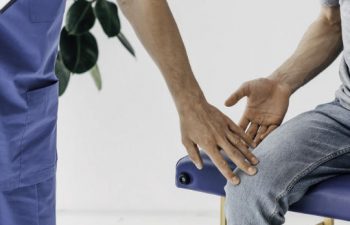
Knee sprains are common and can happen to anyone. Knee sprains are when one or more ligaments in the knee are torn or overstretched. These ligaments hold the knee together, providing function and stability, and are connected outside and inside the knee joint, connecting the top of the tibia to the lower femur. There are four main ligaments that stabilize the knee joint, and stretching or tearing any of them can cause a sprain.
Knee Sprains and Symptoms
The four ligaments in the knee are the ACL (anterior cruciate ligament), the PCL (posterior cruciate ligament), the LCL (lateral collateral ligament) and the MCL (medial collateral ligament). The ACL and the PCL form an “X” across the joint, providing stability for the knee to flex and extend. The LCL runs along the outside of the knee and helps to keep it stable on the outer side, while the MCL runs along the inside of the knee, proving stability from the inner side.
When any of the four ligaments are damaged by the knee being pushed out of alignment, it can cause a knee sprain. Common causes of knee sprains are sports injuries; changing direction while running or collisions with other players, falls and road accidents.
Common symptoms of a knee strain include:
- A tearing or popping sensation
- Swelling and bruising
- A loose of unstable feeling
- Pain and tenderness
- Buckling
- Muscle spasms
- Stiffness
Treatments for Knee Sprains
Knee sprains are graded from 1 to 3. A grade 1 is an overstretched ligament, 2 is a partially torn ligament and grade 3 is severely torn or separated. In most cases, conservative treatments are all that are required for grade 1 and 2 knee sprains. This includes pain medication and R.I.C.E., which means Rest, Ice, Compression and Elevation.
Exercises can help to strengthen the knee joint and the ligaments, but let it rest first, especially if there is pain and swelling. Recovery can take from 2 to 4 weeks. If the knee sprain is grade 3, then surgery may be required. First, you’ll need an examination from a medical professional, which can include an X-ray if there is suspected bone damage. Arthroscopic surgery may be required to reattach or replace the torn ligament. Surgery can take 4 to 6 months to fully recover, with the help of physical therapy exercises.
If you suspect you have a knee sprain or another problem with your knee joint, schedule an appointment with Dr. Farzin Kabaei at Robotic Hip and Knee Replacement LA. We use the latest medical technologies and techniques for optimal recovery with a personalized approach.
Posted on behalf of
8436 West 3rd Street Suite 800
Los Angeles, CA 90048
Phone: (310) 792-9300
Email: fk@docsspineortho.com
Mon - Fri 8AM - 5PM